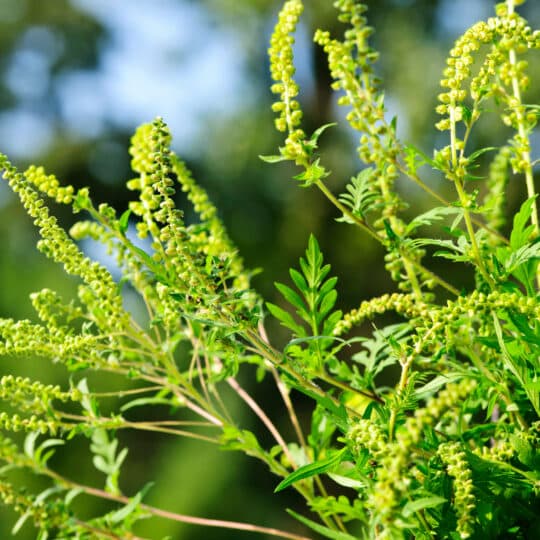Fall Allergens in Your Yard
How to Help Limit the Effects
Posted
September 21, 2023

Fall is a fun time full of outdoor festivals, trips to the orchard, and getting cozy by a bonfire—except if you suffer from seasonal allergies. Some of the top fall allergens include smoke, mold, and ragweed. These sneeze-inducing substances can be growing in your garden and spreading through the air. Here’s how to limit their effects.
Fall Allergens in Your Yard
Spring and fall are the two seasons when allergy sufferers may suffer the most. Partly because these seasons are swarming with pollen. Different types of plants produce more potent allergic reactions. One of the top producers in the fall is ragweed. This plant typically grows and releases pollen between August and September. So if you see it in your yard or garden, it could be why you’re sniffly.
Ragweed Vs Goldenrod
Some may confuse these two similar looking plants, but one is more beneficial than the other. Ragweed has long, skinny spires of greenish yellow flowers that don’t stand out as much from the plant. Since it can grow to be about eight feet tall, It’s typically taller than a goldenrod which only usually gets to six feet. Another way you can tell the difference is by looking at the leaves. Ragweed stems are tinted with purple and have fern-like leaves.
Goldenrod also produces long, green stems that put out clusters of yellow flowers. These bursts of color don’t trigger allergies, but they do attract pollinators. The smooth, green leaves are not divided like ragweed. If you notice more bees and butterflies are attracted to the plant, it’s probably goldenrod.
Moldy Leaves & Fungi
Another reason allergies kick into high gear this time of year is the changes in weather. An increase in humidity and precipitation provides an ideal environment for mold to grow. You may notice more mushrooms growing in your lawn and fungi appearing in your garden. There’s also the possibility of mold forming in piles of leaves layering the grass. Wet wood piles are also a breeding place for mold and decay.
The best way to prevent mold and fungus is by cleaning up any debris and creating a less desirable environment for it to spread. Mow or rake and remove any fallen leaves. Shredded leaves make an excellent mulch for the garden, so it’s even more of an incentive to get it off your grass.
If you notice fungi growing on the base of trees, it’s best to get this inspected by a certified arborist. While it could be a natural occurrence, it can also weaken the bark and branches, leading to a hazardous situation.
Store firewood in a covered enclosure to help prevent mold and rot. Proper storage of wood also helps prevent insects, rodents, and other wildlife from making it a home. Also, before you strike a match, consider whether the smoke is worth it if your allergies will only make you miserable.
Surviving the Fall Allergens
The bad news: mid-September is typically the peak of ragweed season. So if you’re currently congested, sneezing, and itching your eyes, this could be a reason why.
The good news: it’s almost over. Once the weather cools, mold and fungi are likely to die along with the ragweed. Now you also know some preventative measures to take to help limit the effects. Of course, over-the-counter allergy meds are also widely available.
Talk to your doctor about your options for dealing with any allergy symptoms. Contact Cardinal Lawns for your options when it comes to preventing allergen-producers from popping up in your yard.

Download Your FREE Lawn Weed Guide
Before weeds take over your yard this season, learn to identify and prevent them in the first place. Keep your lawn looking great all year!